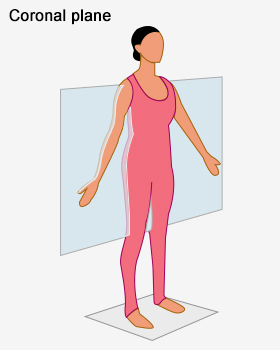Instructions for Side by Side Printing
- Print the notecards
- Fold each page in half along the solid vertical line
- Cut out the notecards by cutting along each horizontal dotted line
- Optional: Glue, tape or staple the ends of each notecard together
Chapter 1: Orientation of the Human Body (Exam 1)
front 1 What is the definition of Anatomy? | back 1 The study of the structure of the human body |
front 2 What is the definition of Physiology? | back 2 Study of body function |
front 3 What is microscopic anatomy? | back 3
|
front 4 What is the order of hierarchy of structural organization? | back 4
|
front 5 On which level are atoms the tiny building blocks of matter? | back 5 Chemical level |
front 6 On which level are macromolecules the building blocks of structures? | back 6 Cellular level |
front 7 Define Cells | back 7
|
front 8 Define Organ | back 8 A group of tissues that perform a common function or functions |
front 9 Define Tissue | back 9 A group of cells that reform a common function or functions |
front 10 What are the four types of tissue? | back 10
|
front 11 What is organ system? Give examples | back 11 A group of organs that perform a common function or functions
|
front 12 Describe Anatomical Position | back 12
|
front 13 What does the axial region consist of? | back 13 It is the main axis:
|
front 14 The trunk consists of | back 14
|
front 15 The appendicular region consists of | back 15 Limbs or appendages |
front 16 Describe superior in anatomical position | back 16 Toward the head end or upper part of a structure or the body Above |
front 17 Describe inferior in anatomical postion | back 17 Away from the head if toward the lower part of a structure or the body; Below |
front 18 Describe medial in anatomical position | back 18 Toward or at the midline of the body On the inner side of |
front 19 Describe lateral in anatomical position | back 19 Away from the midline of the body On the outer side of |
front 20 Describe Proximal in anatomical position | back 20 Closer to the origin of the body part or the point of attachment of a limb to the body trunk |
front 21 Describe distal in anatomical position | back 21 Father from the origin of a body part or the option of attachment of a limb to the body trunk |
front 22 Describe Anterior (ventral) in anatomical position | back 22 Toward or at the front of the body In front of |
front 23 Describe Posterior (dorsal) in anatomical position | back 23 Toward or at the back of the body; Behind |
front 24 Describe the midsagittal plane | back 24  On the midline of body a plane extends vertically and divides the body into left and right parts |
front 25 Describe the frontal (coronal) plane | back 25  Extends vertically and divides the body into anterior and posterior parts |
front 26 Describe the transverse plane | back 26  Runs horizontally from right to left, dividing the body into superior and inferior parts |
front 27 What are the two large cavities of the body? | back 27
|
front 28 How is the dorsal body cavity subdivided? | back 28
|
front 29 Cranial cavity encloses the ... | back 29 Brain |
front 30 Vertebral cavity encloses the ... | back 30 Spinal cord |
front 31 Ventral body cavity contains which organs? | back 31 Visceral organs Lungs, heart, intestines and kidneys |
front 32 What are the two main divisions of the ventral body cavity? | back 32 Thoracic cavity and abdominopelvic cavity |
front 33 What are the three parts of the thoracic cavity? | back 33
|
front 34 Pleural cavity contains the ... | back 34 Lungs |
front 35 Mediastinum contains the ... | back 35 Heart and the other thoracic organs |
front 36 The heart is surrounded by? | back 36 The pericardial cavity |
front 37 What are the two parts of the abdominopelvic cavity? | back 37 Abdominal cavity Pelvic cavity |
front 38 What is the superior part of abdominopelvic cavity? | back 38 abdominal cavity |
front 39 What does the abdominal cavity contain? | back 39 The liver, stomach, kidneys and organs |
front 40 What is the inferior part of the abdominal cavity? | back 40 Pelvic cavity |
front 41 What does the pelvic cavity contain? | back 41 The bladder, some reproductive organs and the rectum |
front 42 Many organs in the abdominopelvic cavity are surrounded by? | back 42 Peritoneal cavity |
front 43 What cavities are serous cavities? | back 43
|
front 44 What are serous cavities lined with? | back 44 Serous membrane (serosa) |